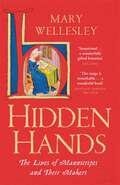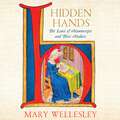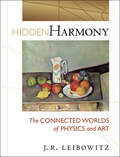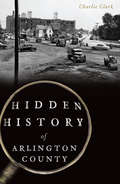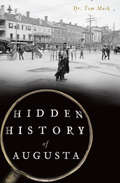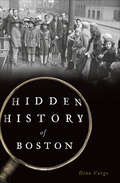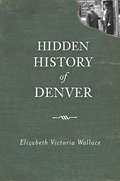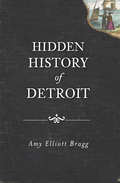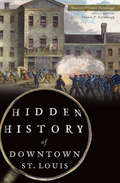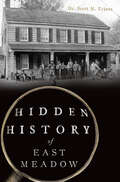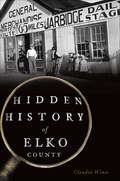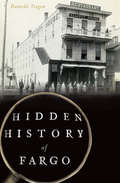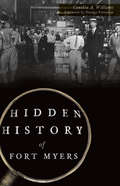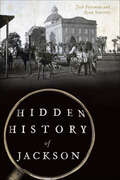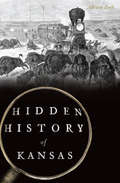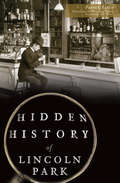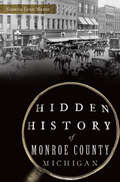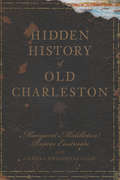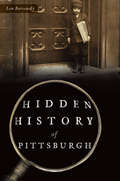- Table View
- List View
Hidden Hands: The Lives of Manuscripts and Their Makers
by Mary WellesleyManuscripts teem with life. They are not only the stuff of history and literature, but they offer some of the only tangible evidence we have of entire lives, long receded. Hidden Hands tells the stories of the artisans, artists, scribes and readers, patrons and collectors who made and kept the beautiful, fragile objects that have survived the ravages of fire, water and deliberate destruction to form a picture of both English culture and the wider European culture of which it is part.Without manuscripts, she shows, many historical figures would be lost to us, as well as those of lower social status, women and people of colour, their stories erased, and the remnants of their labours destroyed.From the Cuthbert Bible, to works including those by the Beowulf poet, Margery Kempe, Julian of Norwich, Sir Thomas Malory, Chaucer, the Paston Letters and Shakespeare, Mary Wellesley describes the production and preservation of these priceless objects. With an insistent emphasis on the early role of women as authors and artists and illustrated with over fifty colour plates, Hidden Hands is an important contribution to our understanding of literature and history.
Hidden Hands: The Lives of Manuscripts and Their Makers
by Mary WellesleyManuscripts teem with life. They are not only the stuff of history and literature, but they offer some of the only tangible evidence we have of entire lives, long receded. Hidden Hands tells the stories of the artisans, artists, scribes and readers, patrons and collectors who made and kept the beautiful, fragile objects that have survived the ravages of fire, water and deliberate destruction to form a picture of both English culture and the wider European culture of which it is part.Without manuscripts, she shows, many historical figures would be lost to us, as well as those of lower social status, women and people of colour, their stories erased, and the remnants of their labours destroyed.From the Cuthbert Bible, to works including those by the Beowulf poet, Margery Kempe, Julian of Norwich, Sir Thomas Malory, Chaucer, the Paston Letters and Shakespeare, Mary Wellesley describes the production and preservation of these priceless objects. With an insistent emphasis on the early role of women as authors and artists, Hidden Hands is an important contribution to our understanding of literature and history.(P) 2021 Quercus Editions Limited
Hidden Harmony: The Connected Worlds of Physics and Art
by Jack R. LeibowitzMost "art and science" books focus on the science of perspective or the psychology of perception. Hidden Harmony does not. Instead, the book addresses the surprising common ground between physics and art from a novel and personal perspective. Viewing the two disciplines as creative processes, J.R. Leibowitz supplements existing and original research with illustrations to demonstrate that physics and art share guiding aesthetics and compositional demands and to show how each speaks meaningfully to the other. Hidden Harmony is the first serious look at what art and physics, as creative processes, have in common. Without assuming a background either in art or physics, the author widens our experience and understanding of both domains by exploring how concepts such as balance and re-balance, coherence and unity, and symmetry and broken symmetry affect and are affected by artistic vision and scientific principle. He reveals shared themes and understandings in each field and adroitly illustrates the parallels between the strategies guiding the dabs of color and layers of images in a work of art and those guiding the assembly of physical evidence into models of the physical world. Featuring examples of paintings and sculptures and complementary examples of physical concepts, this contemplative work helps us see art and physics as artists and physicists do.
Hidden History of Arlington County (Hidden History)
by Charlie ClarkArlington County, for two centuries a center for government institutions, is a vibrant part of the Washington, D.C., community. Many notable figures made their home in the area, like Supreme Court chief justice Warren Burger, General George “Blood ’n’ Guts” Patton and a beauty queen who almost married crooner Dean Martin. The drama of Virginia’s first school integration unfolded in Arlington beginning in the late 1950s. In the 1960s, two motorcycle gangs clashed in public at a suburban shopping center. Local author, historian and “Our Man in Arlington” Charlie Clark uncovers the vivid, and hidden, history of a capital community.
Hidden History of Augusta (Hidden History)
by Dr Tom MackSituated along the Georgia border, Augusta is known for its golf, beautiful private gardens and southern culture. But its history is also brimming with strange stories yet to be told. A beleaguered German princess gave the city its name. A "haunted pillar" survived a tornado that destroyed the area in 1878. The famous Wright brothers opened a branch of their flying school here in 1911. Author and historian Tom Mack uncovers and celebrates these gems hidden in Augusta's rich and teeming history.
Hidden History of Boston: History Through Architecture (Hidden History)
by Dina VargoQuirky and little-known true stories of one of America&’s most historic cities. Boston may play a big role in American history textbooks, but it also has quite a bit of forgotten past. For example, during the colonial era, riotous mobs celebrated their hatred of the pope in an annual celebration called Pope&’s Night. In 1659, Christmas was made illegal, a ban by the Puritans that remained in effect for twenty-two years. William Monroe Trotter published the Boston Guardian, an independent African American newspaper, and was a beacon of civil rights activism at the turn of the century. And in more recent times, a centuries-long turf war played out on the streets of quiet Chinatown, ending in the massacre of five men in a back alley in 1991. Author and historian Dina Vargo shines a light into the cobwebbed corners of Boston&’s hidden history in this riveting read, complete with illustrations.
Hidden History of Denver (Hidden History)
by Elizabeth Victoria WallaceWhen prospectors set up camp on Cherry Creek in 1858, Denver emerged as a lightning rod for the extraordinary. Time has washed away so many unusual stories�from the dark days of nineteenth century Law and Order League lynchings and the KKK�s later rise and fall to the heroism of suffragettes and the touching plight of the gypsies. Elizabeth Wallace knocks the dust off these details and introduces readers to characters like world heavyweight boxing champion Charles L. �Sonny� Liston, hit-man turned rodeo promoter Leland Varain, aka �Diamond Jack,� and the city�s daring wall dogs, whose hand-painted building advertisements are fading reminders of a bygone Denver.
Hidden History of Detroit (Hidden History Ser.)
by Amy Elliott Bragg&“Engaging&” stories of what the Motor City was like before the invention of the motor, with photos and illustrations (Detroit Metro-Times). Long before it became the twentieth-century automotive capital, Detroit was a muddy port town full of grog shops, horse races, haphazard cemeteries, and enterprising bootstrappers from all over the world. In this lively book you&’ll discover the city&’s forgotten history and meet a variety of unforgettable characters—the argumentative French fugitive who founded the city; the tobacco magnate who haunts his shuttered factory; the gambler prankster millionaire who built a monument to himself; the governor who brought his scholarly library with him on canoe expeditions; and the historians who helped create the story of Detroit as we know it: one of the oldest, rowdiest, and most enigmatic cities in the Midwest.
Hidden History of Downtown St. Louis (Hidden History)
by Maureen O'Connor Kavanaugh Thomas P. KavanaughA reputation as the town of shoes, booze and blues persists in St. Louis. But a fascinating history waits just beneath the surface in the heart of the city, like the labyrinth of natural limestone caves where Anheuser-Busch got its start. One of the city’s Garment District shoe factories was the workplace of a young Tennessee Williams, referenced in his first Broadway play, The Glass Menagerie. Downtown’s vibrant African American community was the source and subject of such folk-blues classics as “Frankie and Johnny” and “Stagger Lee,” not to mention W.C. Handy’s classic “St. Louis Blues.” Navigate this hidden heritage of downtown St. Louis with author Maureen Kavanaugh.
Hidden History of Dubuque (Hidden History)
by Susan Miller HellertPoised on the banks of the mighty Mississippi River, Dubuque provided a vital entry point for westward expansion. Explorers, Native Americans, fur traders, lead miners and pilgrims all played a part in the little-known history of Iowa's Driftless Region. It was Dubuque that contributed the first military company in the country for service at the start of the Civil War. Jefferson Davis made a foray into the city in pursuit of lead miners. And gangster Al Capone reportedly used the Hotel Julien as a retreat and hideout. Uncover these lost stories and more with author and historian Susan Miller Hellert as she chronicles the fascinating and all-but-forgotten tales of Dubuque and the surrounding region.
Hidden History of East Meadow (Hidden History)
by Dr. Scott EckersBest known for Baby Boom-era housing developments that transformed potato fields and orchards into suburban sprawl, East Meadow's past is full of fascinating long-forgotten events. Rediscover violent feuds of jealous farmers, such as the love triangles of the 19th century Brower clan. Marvel at the unlikely escapades of eccentric millionaire Jacques Lebaudy, who believed he was a sovereign emperor while living in a Gilded Age Salisbury estate. Explore the exponential growth of one of New York's original school districts, full of political interference and drama that climaxed with a Pete Seeger performance sanctioned by the Court of Appeals of the State of New York
Hidden History of Elko County (Hidden History)
by Claudia WinesElko County in Nevada's remote northeastern corner has long attracted independent, spirited individuals determined to carve out lives of their own. Born to former slaves, Henry Harris worked his way from John Sparks's house hand to one of the most respected buckaroos in the region. Pete Itcaina, the unlikely millionaire, once bought a local bar on the spot just to fire the bartender, who mistook Itcaina for a bum and refused to serve him. The beautiful cattle rustler Susie Raper charmed her way out of numerous arrests and trials, despite her trail of dead husbands. Local author Claudia Wines excavates sagas buried in the dust and probes conventional wisdom surrounding local legend.
Hidden History of Fargo (Hidden History)
by Danielle TeigenFueled by ambition and pipe dreams, Fargo�s earliest residents created an entire city out of the dust of a flat, desolate prairie. Roberts Street might not exist if it weren�t for Matilda Roberts, a resourceful pioneer wife who encouraged her husband�s cousin to set up his law firm on that important downtown thoroughfare. O.J. deLendrecie generated so much success through his retail store that he was able to buy President Theodore Roosevelt�s ranch in western North Dakota. Oliver Dalrymple may have been the bonanza farm king, but the better manager was his rival, Herbert Chaffee of the Amenia and Sharon Land Company. Author Danielle Teigen reveals the intriguing true stories behind many of the most engaging characters and what continues to make the �Gateway to the West� unique.
Hidden History of Flint (Hidden History)
by Gary FlinnBeneath Flint’s auto history lies a buried past. Local Civil War hero Franklin Thompson was actually Sarah Edmonds in disguise. Thread Lake’s Lakeside Amusement Park offered seaplane rides and a giant roller coaster partly built over the water before closing in 1931. Smith-Bridgman’s, the largest department store in town, reigned supreme for more than a century at the same location. And the city’s most prolific inventor, Lloyd Copeman, created the electric stove, flexible ice cube tray and automatic toaster. Gary Flinn showcases the obscure and surprising elements of the Vehicle City’s past, including how the 2014 water crisis was a half century in the making.
Hidden History of Fort Collins (Hidden History)
by Barbara FlemingFrom its Wild West days to the early twentieth century, Fort Collins boasted its share of colorful characters. British import Edith Boothroyd saved a mare from meeting a tragic fate after the bridge she and the horse were traveling across unexpectedly collapsed. In 1915, barnstormer Billy Parker built his first biplane in a local field. Happy Jack slipped away from prison after slyly convincing the jailer to loosen his restraints. And Francis Carter-Cotton left investors holding the bag when he fled to Canada after racking up $300,000 in debt. Barbara Fleming divulges these entertaining stories and more.
Hidden History of Fort Myers
by Cynthia A. Williams Denége PattersonAlthough best known as the winter home of Thomas Edison and Henry Ford, Fort Myers has one of the most engaging and extraordinary histories of any city in Florida. The spawn of a hurricane, Fort Myers began as a U.S. Army post during Florida�s Seminole Wars. During the Civil War, it became a battleground between Confederates and Yankees for cattle and, after the war, a gun-slinging cowboy town. New York cartoonist Walt McDougall blew into the area on a fishing trip, and his glowing description lured down other wealthy Yankee sportsmen who helped turn this isolated frontier town into a modern tourist destination. Historian and author Cynthia Williams explores the hidden stories behind the growth of this beautiful city.
Hidden History of Greenville County (Hidden History)
by Alexia Jones HelsleyHistorically, Greenville County owes much to its natural advantages of scenery, location and abundant water, but it has also benefited from its colorful characters, such as Richard Pearis, Vardry McBee, Richard Furman and the Earle family. Hidden History of Greenville County details the personalities, places and events that have given Greenville its progressive, diverse environment. Join archivist and history professor Alexia Helsley as she explores some of these individuals and their contributions, as well as little-known events in the area and the ever-fascinating "Dark Corner." From mansions to murders, learn things about Greenville County history that you've never encountered before.
Hidden History of Jackson (Hidden History)
by Josh Foreman Ryan StarrettThe history of Jackson is filled with gripping tales of horrors and heroism. Join Ryan Starrett and Josh Foreman as they reveal the hidden past of the City with Soul.A recording company founded in the mid-1960s with the expectation of competing with New Orleans and Memphis was a national success, outlasting its better-funded rivals. Known as the "Devil's Backbone," the Natchez Trace is the graveyard for countless travelers slain by the road's numerous serial killers, brigands and land pirates. Yet one mass grave stands above the others: the Boyd Mounds, which hold the remains of thirty-one Choctaws. Although legend has it that the father of Jackson, Louis LeFleur, was a Canadian trapper famous in high society for his dancing, the truth is even stranger.
Hidden History of Kansas (Hidden History)
by Adrian ZinkKansas’ storied past is filled with fascinating firsts, humorous coincidences and intriguing characters. A man who had survived a murderous proslavery massacre in 1858 hanged his would-be executioner five years later. A wealthy Frenchman utilized his utopian ideals to create an award-winning silk-producing commune in Franklin County. A young boy’s amputated arm led to the rise of Sprint Corporation. The first victim of the doomed Donner Party met her end in Kansas. In 1947, a housewife in Johnson County, indignant at the poor condition of the local school for black children, sparked school desegregation nationwide. Author and historian Adrian Zink digs deep into the Sunflower State’s history to reveal these hidden and overlooked stories.
Hidden History of Lincoln Park (Hidden History)
by Patrick ButlerBefore Lincoln Park cemented its trendy reputation, plenty of odd and unruly history managed to settle into its foundation. A Viking ship, mob henchmen and ladies of the evening all took up residence in the same part of town where Dwight L. Moody went from selling soles to saving souls. Thanks to a Confederate ferryboat crewman, many of Lincoln's personal effects belong to the neighborhood named after him. Patrick Butler uncovers Lincoln Park's forgotten contributions to Chicago's heritage, from the "Pleasure Wheel" on Navy Pier to the city's cycling craze.
Hidden History of Martha's Vineyard (Hidden History)
by Thomas DresserBehind the mansions and presidential vacations of Martha’s Vineyard hide the lost stories and forgotten events of small-town America. What was the island’s role in the Underground Railroad? Why do chickens festoon Nancy Luce’s grave? And how did the people of the Vineyard react in 1923 when the rumrunning ship John Dwight sank with the island’s supply of liquor aboard? Delve deep below the surface of history to discover the origin and meaning of local place names and the significance of beloved landmarks. Celebrated local historian Thomas Dresser unearths the little-known stories that laid the foundations for the community of Martha’s Vineyard.
Hidden History of Monroe County, Michigan (Hidden History)
by Shawna Lynn MazurOften overshadowed by its larger neighbors, Monroe County offers a rich tapestry of history for those willing to look.French-Canadian settlers left behind legends of monsters, ghosts, and witches. In war time, the community answered the call to arms with more soldiers per capita than any other county in the nation and proved a suitable hometown to take refuge between gun shots from none other than George Armstrong Custer. Like most communities, its sordid past reveals crimes and tragedies--including body snatching. More recently, a partial nuclear meltdown brought the city to the brink of disaster, but Monroe not only survived but now thrives.Join local author Shawna Lynn Mazur for a trip through little-known and forgotten parts of Monroe County's past.
Hidden History of New Haven (Hidden History)
by Kathleen Hubbard Robert HubbardThe celebrated history of New Haven often overshadows its fascinating and forgotten past. The Elm City was home to America's first woman dentist, an architect who designed the tallest twin towers in the world and a medical student who used toy parts to create an artificial heart pump. A city noted as the home of one of the top universities in the world, New Haven is also home to the third-oldest independent school in the United States, the first African American to receive a PhD degree and the founding of what would become the largest Catholic fraternal benefit society in the world. The city's share of disasters includes Connecticut's worst aviation crash, a zookeeper who was mauled to death and a fire at the Rialto Theater. Local authors Robert and Kathleen Hubbard reveal the rich and fascinating cultural legacies of one of New England's most treasured cities.
Hidden History of Old Charleston (Hidden History)
by Margaret Middleton Eastman Edward FitzSimons GoodFrom the Lowcountry's first recorded duel to old-fashioned summers at the "hottest spot in town", these pages will captivate you with stories of people, events and places that have all but vanished from memory. Find out the real history behind some of Charleston's beloved mansions and learn about the early plantations and their owners. Join the authors as they relate the riots and romance, the preservation and politics - and even a ghost story - from Charleston's hidden history.
Hidden History of Pittsburgh (Hidden History)
by Len BarcouskyWhen Mark Twain visited in 1884, he claimed to spy a little bit of hell in Pittsburgh's smoky appearance. Twain's observations are among the many riveting firsthand accounts and anecdotes to be found in the archives of the Pittsburgh Post-Gazette. The Great War hit home after the sinking of the Lusitania, which carried more than a dozen Pittsburgh residents. A few years later, cheering throngs of black and white residents lined downtown streets to welcome African American soldiers returning home from the conflict. The Ringling Brothers Circus held its last outdoor performance here in 1956 and left eight hundred show workers without jobs in the city. With these stories from the archives and more, veteran journalist Len Barcousky shines a light on the hidden corners of Pittsburgh's history.
